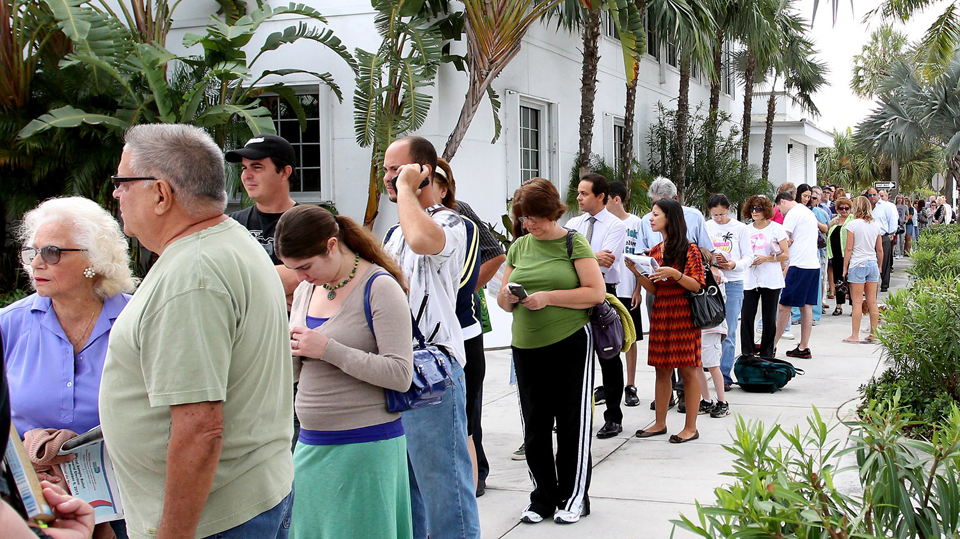
WASHINGTON—Progressives, unionists and their allies in the Democratic Party – and other organizations – may not like to hear this, but demography isn’t destiny when it comes to presidential elections, a new study says.
As a matter of fact, the report adds, between now and 2036, there’s a likelihood of at least one rerun of the 2016 result: Democrats winning the popular vote, and Republicans winning the Electoral College. And another possibility is a flat-out 269-269 Electoral College tie.
The four think tanks in D.C. uses census data and population projections – including growth rates among white, African Americans, Latinos, Asian-Americans and other groups, state by state — to confirm the overall projection the U.S. is becoming less white and more multi-ethnic.
The Census Bureau projects whites will lose their absolute majority among all U.S. residents by 2044. That would mimic several states, notably California, Hawaii and New Mexico, which now have no dominant group. Non-Hispanic whites have already lost their absolute majority among school children, the census projections add.
The catch, say the demographers in their latest study, is not just in population growth among minority groups, but where that growth occurs. By 2020 those three states, plus Texas and D.C. will be majority-minority and two more will be 40 percent-50 percent majority-majority. Others join them by 2036. That uneven increase leads to splits between popular majorities for Democrats and GOP electoral majorities.
“Demographics in the United States are shifting quickly, and both major political parties must adapt sooner rather than later to the changing electorate. An increasingly diverse but aging electorate holds promise and pitfalls for the Democratic Party and Republican Party alike,” said report co-author Ruy Teixiera, a senior fellow at the Center for American Progress. Thus presidential elections could produce widely varying conclusions.
Besides CAP, the other think tanks sponsoring The States of Change were the Brookings Institution, the Bipartisan Policy Center and the Public Religion Research Institute.
“As the 2016 election showed, long-held beliefs about turnout and voter preferences may no longer be as reliable as they once were,” Teixeira warns.
If the electorate reverts to the voting patterns it showed in Democratic President Barack Obama’s 2012 win, factoring in turnout percentages for the various groups and the increasing minority share of the overall electorate, the Democratic nominee would be projected to win both the popular vote and the Electoral College in every election from 2020-2036.
After that conclusion, however, things get dicey.
One factor that upset the applecart was the 5.6 percent share of popular votes in 2016 that went to third parties. “When those extra third-party voters are allocated back to one of the two major parties, based on underlying partisan preferences, projections to 2020 show a dead heat in the Electoral College,” the report says.
In other words, a 269-269 electoral tie and the decision goes to the U.S. House of Representatives, where the voting is by state. Though the report did not say so, the last time the House, voting by states, elected the president was the “corrupt bargain” election of 1824.
The analysts predict a rather gloomy future for the GOP in presidential balloting, unless the party can hang on to the White House by turning out the non-college-educated whites — “a still-substantial but shrinking portion of the electorate” — in ever-greater droves with ever-larger margins while picking up more votes among minorities. Their other calculations produce:
- When Trump’s 2016 voting patterns are attributed to the 2020 population, there will be “a modest shift toward more racially diverse voting populations in several states.” And there could be enough such small tilts in states Trump narrowly won – but where minority populations are growing – that the GOP loses them in 2020 and beyond.
- “The turnout of communities of color will continue to play a major deciding role in presidential elections. A scenario that assumes that all racial groups turn out at the same rate improves the voting clout of racial minorities, especially Hispanics and Asians.”
The catch is who those minorities vote for – and where they’re casting those votes.
The report assumes African-Americans stick with the Democratic Party but that thousands of Hispanics and Asian-Americans could – but not necessarily would — shift to the GOP. The report did not say why. In the past, the Republicans have tried to appeal to both groups on cultural grounds, particularly emphasizing traditional male-female marriage.
“In many of the simulations that favor Democrats in the Electoral College, especially those beyond 2020, swing states that favored Republicans in the 2016 election turn Democratic” as the minority share of the population rises, the report says. “These include Florida, North Carolina, Georgia, and Arizona, in the Sun Belt, as well as Pennsylvania, Michigan, Wisconsin, Iowa, and Ohio in the North.”
“But in scenarios where Republicans are Electoral College victors, they retain most of their 2016 swing states and often add new ones, including Nevada, Minnesota, New Hampshire, and Maine.” That’s even though the Hispanic population in Nevada in particular is growing quickly, and all minorities are growing in Minnesota (Asian-Americans) and New Hampshire.
“And a pro-GOP swing of 15 points among Hispanics, Asians, and other non-black racial minorities could result in Republican Electoral College — though not popular vote – wins,” the report says.
- Minorities become the majority by 2020 in Texas, along with California, New Mexico, Hawaii and D.C., and comprise more than 40 percent of the eligible voters in Maryland and Georgia. Heavily GOP Georgia’s minority growth is so large – it’ll be 48 percent non-white by 2036 — the report calls it “a swing state in the waiting.”
“By 2036, eight additional states should cross the 40 percent threshold: Arizona, Alaska, New Jersey, Nevada, Florida, Mississippi, New York, and Louisiana. Four additional states should have majority-minority eligible electorates: Texas in 2019, Nevada in 2030, Maryland in 2031, and Georgia in 2036.”
Meanwhile, 23 states will be 80 percent white in 2020, but only 11 — Maine, Vermont, New Hampshire, West Virginia, Kentucky, North Dakota, Iowa, Wisconsin, Montana, Idaho, and Wyoming – will be four-fifths white in 2036.
“Notably, by 2036, the traditionally heavily white state of Utah should no longer be part of this group, as racial minorities will comprise 25 percent of its eligible voting population due to the projected dispersion of Hispanics and other racial groups throughout the state.” Next-door Nevada will be 55 percent non-white by then. Its eligible voters are 42 percent non-white now.
And even the “white” states will be less white, the report calculates. “By 2036, Iowa’s eligible voters will be 84 percent white, Wisconsin’s will be 80 percent white, and Ohio’s will be 77 percent white.” They’ll also be gray: Even more than the rest of the U.S., there will be a plurality of residents in those three states aged 65 or older, compared to residents between 18-54, and kids.
- The Trump Democrats – could continue to wield outsized influence, depending on their turnout. Trump brought them to the polls in numbers larger than their share of the general population.
“The greatest opportunity for Republicans to extend their 2016 victory model assumes an expansion of the already-substantial voting margin the GOP gained among white non-college-educated voters. When this margin expands by 10 (percentage) points, Republicans win both the 2020 Electoral College and popular vote. They continue to win the Electoral College, though not the popular vote, through 2036, despite broadening diversity and other predicted changes across the country.”
- Ironically, the analysts say, if Hispanics and Asians swing towards the GOP, the non-college whites could swing back to the Democrats. “An increased Republican margin of 15 points among Hispanics, Asians, and other nonblack minority groups, perhaps due to increased outreach efforts, might trigger a swing toward greater Democratic support — back to relatively good 2012 levels — among non-college-educated whites. In such a scenario, the Republicans lose both the popular and electoral vote in 2020.”
“However, in a scenario where increased Republican success among white non-college-educated voters is traded for increased Democratic success among white college graduates” – a key part of the Obama coalition in both 2008 and 2012 – “the GOP does gain an Electoral College victory in 2020, even while losing the popular vote.”
But the Democrats aren’t home free, either, after 2020.
“A narrow Republican reliance on non-college-educated whites would lead, at best, to continued popular vote losses and ever smaller Electoral College wins, which would eventually peter out. While Democrats appear to have the advantage in future popular vote contests, their success in the Electoral College will likely require some combination of intensifying their support among voters of color and improving their margins among white, particularly white non-college-educated, voters.”
That’s even though the non-college educated whites, now 44 percent of white voters, will be 37 percent in just a few years, the report notes.
“This delicate balancing act will provide a challenge for the party that cannot be met by simply waiting for demographic change to reshape the electorate.”
Teixiera and his colleagues threw in cautions at the end of their study.
“First and foremost, these are simulations — not predictions. When talking about results under a given set of assumptions, the authors are not expressing the belief that this is what will happen in a given presidential election.” Instead, the study “is revealing tomorrow’s contours under a certain set of assumptions.”
“While the expectations the authors have about the underlying race, age, and education makeup of the electorate are probably the soundest of their assumptions, those pertaining to voter behavior are more likely to stray from reality. This is not a problem unique to this endeavor—the future itself is inherently uncertain—but it is one worth keeping in mind. As such, the results presented here are best thought of as baselines rather than ironclad truths “
And one caution they did not build in: The impact on minorities of so-called “voter ID” laws and tactics, which GOP-run states have designed to suppress registration and voting among minorities, workers, youthful voters and the old.
“Demographics are not destiny, but steady and predictable changes to the electorate play an important role in defining the landscape of American elections. The authors have every reason to suspect the composition of the American electorate will change dramatically over the next five presidential elections. These shifts — which vary considerably state by state — will force parties and candidates to recalibrate their strategies for success going forward.”
For everyone in the people’s movements the important takeaway for 2020 and beyond is clear: Organize, organize and organize more to get out the vote!










